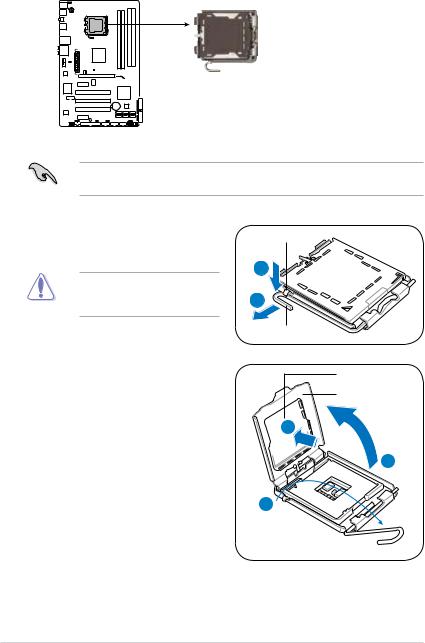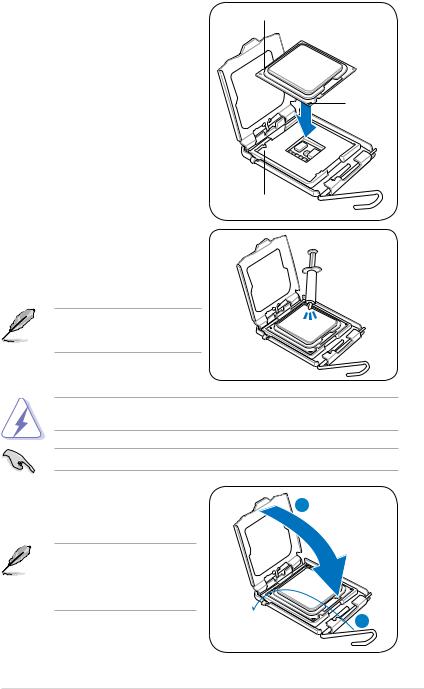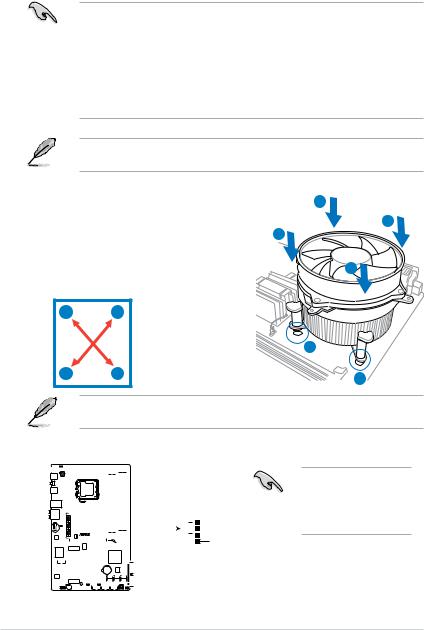Asus P5Q SE2 User Manual

P5Q SE2
Motherboard

E4200
First Edition V1
September 2008
Copyright © 2008 ASUSTeK Computer, Inc. All Rights Reserved.
No part of this manual, including the products and software described in it, may be reproduced, transmitted, transcribed, stored in a retrieval system, or translated into any language in any form or by any means, except documentation kept by the purchaser for backup purposes, without the express written permission of ASUSTeK Computer Inc. (“ASUS”).
Product warranty or service will not be extended if: (1) the product is repaired, modified or altered, unless such repair, modification of alteration is authorized in writing by ASUS; or (2) the serial number of the product is defaced or missing.
ASUS PROVIDES THIS MANUAL “AS IS” WITHOUT WARRANTY OF ANY KIND, EITHER EXPRESS OR IMPLIED, INCLUDING BUT NOT LIMITED TO THE IMPLIED WARRANTIES OR CONDITIONS OF MERCHANTABILITY OR FITNESS FOR A PARTICULAR PURPOSE. IN NO EVENT SHALL ASUS, ITS DIRECTORS, OFFICERS, EMPLOYEES OR AGENTS BE LIABLE FOR ANY INDIRECT, SPECIAL, INCIDENTAL, OR CONSEQUENTIAL DAMAGES (INCLUDING DAMAGES FOR LOSS OF PROFITS, LOSS OF BUSINESS, LOSS OF USE OR DATA, INTERRUPTION OF BUSINESS AND THE LIKE), EVEN IF ASUS HAS BEEN ADVISED OF THE POSSIBILITY OF SUCH DAMAGES ARISING FROM ANY DEFECT OR ERROR IN THIS MANUAL OR PRODUCT.
SPECIFICATIONS AND INFORMATION CONTAINED IN THIS MANUAL ARE FURNISHED FOR INFORMATIONAL USE ONLY, AND ARE SUBJECT TO CHANGE AT ANY TIME WITHOUT NOTICE, AND SHOULD NOT BE CONSTRUED AS A COMMITMENT BY ASUS. ASUS ASSUMES NO RESPONSIBILITY OR LIABILITY FOR ANY ERRORS OR INACCURACIES THAT MAY APPEAR IN THIS MANUAL, INCLUDING THE PRODUCTS AND SOFTWARE DESCRIBED IN IT.
Products and corporate names appearing in this manual may or may not be registered trademarks or copyrights of their respective companies, and are used only for identification or explanation and to the owners’ benefit, without intent to infringe.
ii

Contents
Notices.......................................................................................................... |
vi |
Safety information...................................................................................... |
vii |
About this guide......................................................................................... |
vii |
P5Q SE2 specifications summary.............................................................. |
ix |
Chapter 1: Product introduction
1.1 |
Welcome!....................................................................................... |
1-1 |
|
1.2 |
Package contents.......................................................................... |
1-1 |
|
1.3 |
Special features............................................................................. |
1-1 |
|
|
1.3.1 |
Product highlights............................................................ |
1-1 |
|
1.3.2 |
ASUS unique features..................................................... |
1-2 |
|
1.3.3 |
ASUS Stylish features..................................................... |
1-3 |
|
1.3.4 |
ASUS Intelligent Overclocking features........................... |
1-4 |
1.4 |
Before you proceed...................................................................... |
1-4 |
|
1.5 |
Motherboard overview.................................................................. |
1-5 |
|
|
1.5.1 |
Placement direction......................................................... |
1-5 |
|
1.5.2 |
Screw holes..................................................................... |
1-5 |
|
1.5.3 |
Motherboard layout.......................................................... |
1-6 |
|
1.5.4 |
Layout contents............................................................... |
1-7 |
1.6 |
Central Processing Unit (CPU).................................................... |
1-7 |
|
|
1.6.1 |
Installing the CPU............................................................ |
1-8 |
|
1.6.2 |
Installing the CPU heatsink and fan.............................. |
1-10 |
|
1.6.3 |
Uninstalling the CPU heatsink and fan........................... |
1-11 |
1.7 |
System memory.......................................................................... |
1-11 |
|
|
1.7.1 |
Overview......................................................................... |
1-11 |
|
1.7.2 |
Memory configurations.................................................. |
1-12 |
|
1.7.3 |
Installing a DIMM........................................................... |
1-15 |
|
1.7.4 |
Removing a DIMM......................................................... |
1-16 |
1.8 |
Expansion slots........................................................................... |
1-16 |
|
|
1.8.1 |
Installing an expansion card.......................................... |
1-16 |
|
1.8.2 |
Configuring an expansion card...................................... |
1-16 |
|
1.8.3 |
PCI slots........................................................................ |
1-17 |
|
1.8.4 |
PCI Express x1 slots..................................................... |
1-17 |
|
1.8.5 |
PCI Express x16 slot..................................................... |
1-17 |
1.9 |
Jumpers |
....................................................................................... |
1-17 |
iii

Contents
1.10 |
Connectors.................................................................................. |
1-19 |
|
|
1.10.1 |
Rear panel connectors.................................................. |
1-19 |
|
1.10.2 |
Internal connectors........................................................ |
1-20 |
1.11 |
Software support......................................................................... |
1-27 |
|
|
1.11.1 |
Installing an operating system....................................... |
1-27 |
|
1.11.2 |
Support DVD information............................................... |
1-27 |
Chapter 2: BIOS information
2.1 |
Managing and updating your BIOS............................................. |
2-1 |
|
|
2.1.1 |
ASUS Update utility......................................................... |
2-1 |
|
2.1.2 |
Creating a bootable floppy disk....................................... |
2-3 |
|
2.1.3 |
ASUS EZ Flash 2 utility................................................... |
2-3 |
|
2.1.4 |
AFUDOS utility................................................................ |
2-4 |
|
2.1.5 |
ASUS CrashFree BIOS 3 utility....................................... |
2-6 |
2.2 |
BIOS setup program..................................................................... |
2-7 |
|
|
2.2.1 |
BIOS menu screen.......................................................... |
2-8 |
|
2.2.2 |
Menu bar......................................................................... |
2-9 |
|
2.2.3 |
Navigation keys............................................................... |
2-9 |
|
2.2.4 |
Menu items...................................................................... |
2-9 |
|
2.2.5 |
Sub-menu items.............................................................. |
2-9 |
|
2.2.6 |
Configuration fields.......................................................... |
2-9 |
|
2.2.7 |
Pop-up window.............................................................. |
2-10 |
|
2.2.8 |
Scroll bar....................................................................... |
2-10 |
|
2.2.9 |
General help.................................................................. |
2-10 |
2.3 |
Main menu................................................................................... |
2-10 |
|
|
2.3.1 |
System Time.................................................................. |
2-10 |
|
2.3.2 |
System Date.................................................................. |
2-10 |
|
2.3.3 |
Legacy Diskette A.......................................................... |
2-10 |
|
2.3.4 |
SATA1-6.......................................................................................... |
2-11 |
|
2.3.5 |
Storage Configuration..................................................... |
2-11 |
|
2.3.6 |
System Information........................................................ |
2-12 |
2.4 |
Ai Tweaker menu......................................................................... |
2-12 |
|
2.5 |
Advanced menu.......................................................................... |
2-17 |
|
|
2.5.1 |
CPU Configuration......................................................... |
2-17 |
|
2.5.2 |
Chipset.......................................................................... |
2-18 |
|
2.5.3 |
Onboard Devices Configuration.................................... |
2-18 |
iv

Contents
|
2.5.4 |
USB Configuration......................................................... |
2-19 |
|
2.5.5 |
PCI PnP......................................................................... |
2-19 |
2.6 |
Power menu................................................................................. |
2-20 |
|
|
2.6.1 |
Suspend Mode.............................................................. |
2-20 |
|
2.6.2 |
ACPI 2.0 Support........................................................... |
2-20 |
|
2.6.3 |
ACPI APIC Support....................................................... |
2-20 |
|
2.6.4 |
APM Configuration........................................................ |
2-20 |
|
2.6.5 |
Hardware Monitor.......................................................... |
2-21 |
2.7 |
Boot menu................................................................................... |
2-22 |
|
|
2.7.1 |
Boot Device Priority....................................................... |
2-22 |
|
2.7.2 |
Boot Settings Configuration........................................... |
2-22 |
|
2.7.3 |
Security.......................................................................... |
2-23 |
2.8 |
Tools menu.................................................................................. |
2-24 |
|
|
2.8.1 |
ASUS EZ Flash 2.......................................................... |
2-24 |
|
2.8.2 |
Express Gate................................................................. |
2-24 |
|
2.8.3 |
AI NET 2........................................................................ |
2-25 |
|
2.8.4 |
ASUS O.C. Profile......................................................... |
2-25 |
2.9 |
Exit menu..................................................................................... |
2-26 |
|

Notices
Federal Communications Commission Statement
This device complies with Part 15 of the FCC Rules. Operation is subject to the following two conditions:
•This device may not cause harmful interference, and
•This device must accept any interference received including interference that may cause undesired operation.
This equipment has been tested and found to comply with the limits for a Class B digital device, pursuant to Part 15 of the FCC Rules. These limits are designed to provide reasonable protection against harmful interference in a residential installation. This equipment generates, uses and can radiate radio frequency energy and, if not installed and used in accordance with manufacturer’s instructions, may cause harmful interference to radio communications. However, there is no guarantee that interference will not occur in a particular installation. If this equipment does cause harmful interference to radio or
television reception, which can be determined by turning the equipment off and on, the user is encouraged to try to correct the interference by one or more of the following measures:
•Reorient or relocate the receiving antenna.
•Increase the separation between the equipment and receiver.
•Connect the equipment to an outlet on a circuit different from that to which the receiver is connected.
•Consult the dealer or an experienced radio/TV technician for help.
The use of shielded cables for connection of the monitor to the graphics card is required to assure compliance with FCC regulations. Changes or modifications to this unit not expressly approved by the party responsible for compliance could void the user’s authority to operate this equipment.
Canadian Department of Communications Statement
This digital apparatus does not exceed the Class B limits for radio noise emissions from digital apparatus set out in the Radio Interference Regulations of the Canadian Department of Communications.
This class B digital apparatus complies with Canadian ICES-003.
This symbol of the crossed out wheeled bin indicates that the product (electrical and electronic equipment) should not be placed in municipal waste. Check local regulations for disposal of electronic products.
vi

Safety information
Electrical safety
•To prevent electric shock hazard, disconnect the power cable from the electric outlet before relocating the system.
•When adding or removing devices to or from the system, ensure that the power cables for the devices are unplugged before the signal cables are connected. If possible, disconnect all power cables from the existing system before you add a device.
•Before connecting or removing signal cables from the motherboard, ensure that all power cables are unplugged.
•Seek professional assistance before using an adpater or extension cord. These devices could interrupt the grounding circuit.
•Make sure that your power supply is set to the correct voltage in your area. If you are not sure about the voltage of the electrical outlet you are using, contact your local power company.
•If the power supply is broken, do not try to fix it by yourself. Contact a qualified service technician or your retailer.
Operation safety
•Before installing the motherboard and adding devices on it, carefully read all the manuals that came with the package.
•Before using the product, make sure all cables are correctly connected and the power cables are not damaged. If you detect any damage, contact your dealer immediately.
•To avoid short circuits, keep paper clips, screws, and staples away from connectors, slots, sockets and circuitry.
•Avoid dust, humidity, and temperature extremes. Do not place the product in any area where it may become wet.
•Place the product on a stable surface.
•If you encounter technical problems with the product, contact a qualified service technician or your retailer.
About this guide
This user guide contains the information you need when installing and configuring the motherboard.
How this guide is organized
This guide contains the following parts:
•Chapter 1: Product introduction
This chapter describes the features of the motherboard and the new technology it supports.
•Chapter 2: BIOS setup
This chapter tells how to change system settings through the BIOS Setup menus. Detailed descriptions of the BIOS parameters are also provided.
vii

Where to find more information
Refer to the following sources for additional information and for product and software updates.
1.ASUS websites
The ASUS website provides updated information on ASUS hardware and software products. Refer to the ASUS contact information.
2.Optional documentation
Your product package may include optional documentation, such as warranty flyers, that may have been added by your dealer. These documents are not part of the standard package.
Conventions used in this guide
To make sure that you perform certain tasks properly, take note of the following symbols used throughout this manual.
DANGER/WARNING: Information to prevent injury to yourself when trying to complete a task.
CAUTION: Information to prevent damage to the components when trying to complete a task.
IMPORTANT: Instructions that you MUST follow to complete a task.
NOTE: Tips and additional information to help you complete a task.
Typography
Bold text |
Indicates a menu or an item to select. |
Italics |
Used to emphasize a word or a phrase. |
<Key> |
Keys enclosed in the less-than and greater-than sign means |
|
that you must press the enclosed key. |
|
Example: <Enter> means that you must press the Enter or |
|
Return key. |
<Key1>+<Key2>+<Key3> |
If you must press two or more keys simultaneously, the key |
|
names are linked with a plus sign (+). |
|
Example: <Ctrl>+<Alt>+<D> |
Command |
Means that you must type the command exactly as shown, |
|
then supply the required item or value enclosed in brackets. |
|
Example: At the DOS prompt, type the command line: |
|
afudos /i[filename] |
|
afudos /iP5QSE2.ROM |
viii

P5Q SE2 specifications summary
CPU
Chipset
System bus
Memory
LGA775 Socket for Intel® Core™2 Extreme /Core™2 Quad / Core™2 Duo / Pentium® Dual-Core / Celeron® Dual-Core / Celeron® processors
Compatible with Intel® 05B/05A/06 processors
Intel® P45 / ICH10 with Intel® Fast Memory Access Technology
1600/1333/1066/800MHz
Dual-channel memory architecture
-4 x 240-pin DIMM sockets support unbuffered non-ECC DDR2 1200/1066/800/667MHz memory modules
-Supports up to 16GB system memory
*Refer to www.asus.com or this user manual for the
Memory QVL (Qualified Vendors Lists)
**When you install a total memory of 4GB or more, Windows® 32-bit operating system may only recognize less than 3GB. Hence, a total installed memory of less than 3GB is recommended if you are using a Windows 32-bit operating system.
Expansion slots |
1 x PCIe x16 slot |
|
2 x PCIe x1 slots |
|
3 x PCI slots |
Storage |
Intel ICH10 southbridge supports: |
|
- 6 x Serial ATA 3Gb/s ports |
|
Marvell® 88SE6102 PATA controller supports: |
|
- 1 x UltraDMA 133/100/66 for up to 2 PATA devices |
LAN |
Realtek® 8111C-VCP, PCIe Gigabit LAN controller |
|
featuring AI NET2 |
Audio |
VIA VT1708S, 8-channel High-Definition Audio CODEC |
|
- Supports Jack-detect and Multi-streaming |
|
- Coaxial S/PDIF Out port at back I/O |
|
- ASUS Noise Filter |
USB
BIOS features
12 x USB 2.0 ports (6 at mid-board, 6 at back panel)
8Mb Flash ROM, AMI BIOS, PnP, DMI 2.0, WfM 2.0, SM BIOS 2.5, ACPI 2.0a, ASUS EZ Flash 2, ASUS CrashFree BIOS 3
ASUS unique features ASUS Power Saving Solution:
-ASUS AI Nap ASUS AI Life Features:
-ASUS Express Gate ASUS Crystal Sound:
-ASUS Noise Filter ASUS EZ DIY:
-ASUS O.C. Profile
-ASUS CrashFree BIOS 3
-ASUS EZ Flash 2
(continued on the next page)
ix

P5Q SE2 specifications summary
ASUS exclusive overclocking features
Other features
Rear panel ports
Internal connectors
Manageability
Accessories
Support DVD
Form factor
Intelligent overclocking tools:
-ASUS AI Booster Precision Tweaker:
-vCore: Adjustable CPU voltage at 0.00625V increment
-vDIMM: 6-step DRAM voltage control
SFS (Stepless Frequency Selection):
-FSB tuning from 200MHz to 600MHz at 1MHz increment
-Memory tuning from 667MHz to 1333MHz for DDR2
-PCI Express frequency tuning from 100MHz to 160MHz at 1MHz increment
Overclocking protection:
- ASUS C.P.R. (CPU Parameter Recall)
ASUS MyLogo 2
1 x PS/2 keyboard port
1 x PS/2 mouse port
1 x Coaxial S/PDIF Out port
1 x LAN (RJ-45) port
6 x USB 2.0/1.1 ports
8-channel audio I/O ports
3 x USB connectors support 6 additional USB ports
1 x Floppy disk drive connector
1 x IDE connector
6 x Serial ATA connectors
1 x CPU / 1 x Chassis / 1 x Power fan connectors 1 x COM connector
1 x S/PDIF Out header
1 x Chassis intrusion connector
1 x Front panel audio connector
1 x CD audio in connector
1 x 24-pin ATX power connector
1 x 4-pin ATX 12V power connector
1 x System panel connector
WfM 2.0, DMI 2.0, WOL by PME, WOR by PME, PXE
1 x UltraDMA 133/100/66 cable
2 x Serial ATA cables
1 x I/O shield User Manual
* The floppy disk drive (FDD) cable is purchased separately.
Drivers
AI Suite
ASUS PC Probe II
ASUS Update
Anti-Virus software (OEM version)
ATX form factor: 12 in x 7.6 in (30.5 cm x 19.3 cm)
*Specifications are subject to change without notice.

Chapter 1
Product introduction
1.1Welcome!
Thank you for buying an ASUS® P5Q SE2 motherboard!
The motherboard delivers a host of new features and latest technologies, making it another standout in the long line of ASUS quality motherboards!
Before you start installing the motherboard, and hardware devices on it, check the items in your package with the list below.
1.2Package contents
Check your motherboard package for the following items.
Motherboard |
ASUS P5Q SE2 motherboard |
Cables |
2 x Serial ATA cables |
|
1 x Ultra DMA 133/100/66 cable |
Accessories |
1 x I/O shield |
Application CD |
ASUS motherboard Support DVD |
Documentation |
User Manual |
• If any of the above items is damaged or missing, contact your retailer.
• The floppy disk drive (FDD) cable is purchased separately.
1.3Special features
1.3.1Product highlights
Green ASUS
This motherboard and its packaging comply with the European Union’s Restriction on the use of Hazardous Substances (RoHS). This is in line with the ASUS vision of creating environment-friendly and recyclable products/packaging to safeguard consumers’ health while minimizing the impact on the environment.
Intel® Core™2 Extreme / Core™2 Quad / |
. |
Core™2 Duo CPU support |
|
This motherboard supports the latest Intel® Core™2 Extreme / Core™2 Quad /
Core™2 Duo processors in the LGA775 package. With 1600/1333/1066/800MHz Front Side
Bus (FSB), the Intel® Core™2 processors are among the most powerful CPUs in the world. See page 17 for details.
ASUS P5Q SE2 |
1- |

Intel® P45 Chipset
The Intel® P45 Express Chipset is designed to support dual-channel DDR2 800/667MHz architecture, 1333/1066/800MHz FSB, PCIe 2.0, and multi-core CPUs. It supports the Intel® Fast Memory Access technology that significantly optimizes the use of available memory
bandwidth and reduces the latency of the memory accesses.
PCIe 2.0 support 
This motherboard supports the latest PCIe 2.0 devices for double speed and bandwidth which enhances system performance.
Dual-channel DDR2 1200 memory support 
This motherboard supports DDR2 memory that features data transfer rates of
1200/1066/800/667MHz to meet the higher bandwidth requirements of the latest operating systems, 3D graphics, multimedia, and Internet applications. The dual-channel
DDR2 architecture doubles the bandwidth of your system memory to boost system performance, eliminating bottlenecks with peak bandwidths up to 19.2GB/s. See page 1-13 for details.
Serial ATA 3Gb/s technology 
This motherboard supports hard drives based on the Serial ATA (SATA) 3Gb/s storage specifications, delivering enhanced scalability and doubling the bus bandwidth for high-speed data retrieval and save.
1.3.2ASUS unique features
ASUS AI Life Features 
Express Gate
Taking only 5 seconds to go online from bootup, Express Gate is the one-stop gateway to instant fun! It’s a unique motherboard built-in OS. You can utilize the most popular
Instant Messengers (IM) like MSN, Skype, Google talk, QQ, and Yahoo! Messenger to keep in touch with friends, or quickly check on the weather and e-mails just before leaving your house. What’s more, the user-friendly picture manager lets you view your pictures without entering Windows at anytime!
• The actual boot time depends on the system configuration.
•ASUS Express Gate supports file uploading from SATA HDDs, ODDs and USB drives and downloading to USB drives only.
1- |
Chapter 1: Product introduction |

ASUS Power Saving Solution 
ASUS Power Saving solution intelligently and automatically provides balanced computing power and energy consumption.
AI Nap
With AI Nap, users can instantly snooze your PC without terminating the tasks. The system will continue operating at minimum power and noise when user is temporarily away. It keeps downloading files or running applications in quietest state while you are sleeping. Simply click keyboard or mouse, you can swiftly wake up the system in a few seconds.
ASUS Crystal Sound 
This feature can enhance speech-centric applications like Skype, online game, video conference and recording.
Noise Filter
This feature detects repetitive and stationary noises (non-voice signals) like computer fans, air conditioners, and other background noises then eliminates it in the incoming audio stream while recording.
ASUS EZ DIY 


ASUS EZ DIY feature collection provides you with easy ways to install computer components, update the BIOS or back up your favorite settings.
ASUS O.C. Profile
The motherboard features the ASUS O.C. Profile that allows users to conveniently store or load multiple BIOS settings. The BIOS settings can be stored in the CMOS or a separate file, giving users freedom to share and distribute their favorite overclocking settings. See page 2-25 for details.
ASUS CrashFree BIOS 3
The ASUS CrashFree BIOS 3 allows users to restore corrupted BIOS data from a bootable floppy disk, USB flash disk, or the motherboard Support DVD containing the original BIOS file. See page 2-6 for details.
ASUS EZ Flash 2
EZ Flash 2 is a user-friendly BIOS update utility. Simply launch this tool and update
BIOS from a USB flash disk before entering the OS. You can update your BIOS only in a few clicks without preparing a bootable floppy disk or using an OS-based utility. See pages 2-3 and 2-24 for details.
1.3.3ASUS Stylish features
ASUS MyLogo2™ 
This feature allows you to convert your favorite photo into a 256-color boot logo for a more colorful and vivid image on your screen. See page 2-22 for details.
ASUS P5Q SE2 |
1- |

1.3.4ASUS Intelligent Overclocking features
AI Booster
The ASUS AI Booster allows you to overclock the CPU speed in Windows® environment without the hassle of booting the BIOS.
Precision Tweaker 
This feature allows you to fine-tune the CPU/memory voltage and gradually increase the memory, FSB, and PCI Express frequency at 1MHz increment to achieve maximum system performance. See page 2-12 to 2-17 for details.
CPU Parameter Recall (C.P.R.) 
The C.P.R. feature of the motherboard BIOS allows automatic re-setting to the BIOS default settings in case the system hangs due to overclocking failure. When the system hangs due to overclocking failure, C.P.R. eliminates the need to open the system chassis and clear the RTC data. Simply shut down and reboot the system, and the BIOS automatically restores the CPU default settings for each parameter.
1.4Before you proceed
Take note of the following precautions before you install motherboard components or change any motherboard settings.
• Unplug the power cord from the wall socket before touching any component.
• Use a grounded wrist strap or touch a safely grounded object or a metal object, such as the power supply case, before handling components to avoid damaging them due to static electricity.
•Hold components by the edges to avoid touching the ICs on them.
•Whenever you uninstall any component, place it on a grounded antistatic pad or in the bag that came with the component.
•Before you install or remove any component, ensure that the ATX power supply is switched off or the power cord is detached from the power supply. Failure to do so may cause severe damage to the motherboard, peripherals, and/or components.
Onboard LED
The motherboard comes with a standby power LED that lights up to indicate that the system is ON, in sleep mode, or in soft-off mode. This is a reminder that you must shut down the system and unplug the power cable before removing or plugging in any motherboard component. The illustration below shows the location of the onboard LED.
P5Q SE2 |
SB_PWR |
|
|
ON |
OFF |
|
Standy Power |
Powered Off |
P5Q SE2 Onboard LED |
|
|
1- |
|
Chapter 1: Product introduction |

1.5Motherboard overview
Before you install the motherboard, study the configuration of your chassis to ensure that the motherboard fits into it.
Ensure that you unplug the power cord before installing or removing the motherboard. Failure to do so can cause you physical injury and damage motherboard components.
1.5.1Placement direction
When installing the motherboard, ensure that you place it into the chassis in the correct orientation. The edge with external ports goes to the rear part of the chassis as indicated in the image below.
1.5.2Screw holes
Place six screws into the holes indicated by circles to secure the motherboard to the chassis.
Do not overtighten the screws! Doing so can damage the motherboard.
Place this side towards. the rear of the chassis


 P5Q SE2
P5Q SE2
|
|
|
|
|
|
|
|
|
|
|
|
|
|
|
|
|
|
|
|
|
|
|
|
|
|
|
|
|
|
|
|
|
|
|
|
|
|
|
|
|
|
|
|
|
|
|
|
|
|
|
|
|
|
|
|
|
|
|
|
|
|
|
|
|
|
|
|
|
|
|
|
|
|
|
|
|
|
|
|
|
|
|
|
|
|
|
|
|
|
|
|
|
|
|
|
|
|
|
|
|
|
|
|
|
|
|
|
|
|
|
|
|
|
|
|
|
|
|
|
|
|
|
|
|
|
|
|
|
|
|
|
|
|
|
|
|
|
|
|
|
|
|
|
|
|
|
|
|
|
|
|
|
|
|
|
|
|
|
|
|
|
|
|
|
|
|
|
|
|
|
|
|
|
|
|
|
|
|
|
|
|
|
|
|
|
|
|
|
|
|
|
|
|
|
|
|
|
|
|
|
|
|
|
|
|
|
|
|
|
|
|
|
|
|
|
|
|
|
|
|
|
|
|
|
|
|
|
|
|
|
|
|
|
|
|
|
|
|
|
|
|
|
|
|
|
|
|
|
|
|
|
|
|
|
|
|
|
|
|
|
|
|
|
|
|
|
|
|
|
|
|
|
|
|
|
|
|
|
|
|
|
|
|
|
|
|
|
|
|
|
|
|
|
|
|
|
|
|
|
|
|
|
|
|
|
|
|
|
|
|
|
|
|
|
|
|
|
|
|
|
|
|
|
|
|
|
|
|
|
|
|
|
|
|
|
|
|
|
|
|
|
|
|
|
|
|
|
|
|
|
|
|
|
|
|
|
|
|
|
|
|
|
|
|
|
|
|
|
|
|
|
|
|
|
|
|
|
|
|
|
|
|
|
|
|
|
|
|
|
|
|
|
|
|
|
|
|
|
|
|
|
|
|
|
|
|
|
|
|
|
|
|
|
|
|
|
|
|
|
|
|
|
|
|
|
|
|
|
|
|
|
|
|
|
|
|
|
|
|
|
|
|
|
|
|
|
|
|
|
|
|
|
|
|
|
|
|
|
|
|
|
|
|
|
|
|
|
|
|
|
|
|
|
|
|
|
|
|
|
|
|
|
|
|
|
|
|
|
|
|
|
|
|
|
|
|
|
|
|
|
|
|
|
ASUS P5Q SE2 |
1- |
||||||||||||||||||||||||||

1.5.3Motherboard layout
KBMS |
PS2_USBPW56 |
|
|
|
|
|
|
|
|
|
|
|
|
|
|
|
|
USB56 |
|
ATX12V |
|
|
|
|
|
|
|
|
|
|
|
|
|
|
|
SPDIF_O |
|
|
|
|
|
module)pin |
module)pin |
|
USB34 |
|
|
|
|
module) |
module) |
||
|
|
|
|
LGA775 |
|
|
|
|
LAN1_USB12 |
|
|
|
(64bit, 240-pin |
(64bit, 240-pin |
B1 (64bit, 240- |
B2 (64bit, 240- |
|
AUDIO |
|
|
|
Intel® |
DDR2DIMM A1 |
DDR2DIMM A2 |
DDR2DIMM_ |
DDR2DIMM_ |
CHA_FAN |
EATXPWR |
|
P45 |
|
|
|
|
|
USBPW1-4 |
|
|
|
|
|
|
||
CPU_FAN |
|
PWR_FAN |
|
|
|
|
|
|
|
|
|
P5Q SE2 |
|
|
|
|
|
RTL |
|
|
|
|
|
|
|
|
|
|
|
|
|
|
|
|
|
8111C |
|
|
|
|
|
|
|
|
|
|
|
|
PCIEX16 |
|
|
|
|
|
|
|
|
|
|
|
|
|
|
|
|
|
|
|
|
|
RTM 870T-954 |
|
|
|
|
|
|
|
|
|
|
|
|
|
|
|
|
|
|
|
|
|
|
|
|
|
|
|
|
|
|
|
|
|
|
|
|
|
|
|
|
|
|
|
PCIEX1_1 |
|
|
|
|
|
|
|
|
|
|
|
|
|
|
|
|
|
|
|
|
|
|
|
|
|
|
|
|
||||||||
|
Super |
|
|
|
|
|
|
|
|
|
|
|
|
|
|
|
|
|
|
|
|
|
|
|
|
|
|
|
|
|
|
|
|
|
|
|
|
|
|
|
|
|
|
|||||
|
|
|
|
|
|
|
|
|
|
|
|
|
|
|
|
|
|
|
|
|
|
|
|
|
|
|
|
|
|
|
|
|
|
|
|
|
|
|
|
|
|
|
||||||
|
|
I/O |
|
|
|
|
|
|
|
|
|
|
|
|
|
|
|
|
|
|
|
|
|
|
|
|
|
|
|
|
|
Intel® |
|
|
|
|
|
|
|
|
||||||||
|
|
|
|
|
|
|
|
|
|
|
|
|
|
|
|
|
PCI1 |
|
|
|
|
|
|
|
|
|
|
|
|
|
|
|
|
|
|
|
|
|
|
|
||||||||
|
|
|
|
|
|
|
|
|
|
|
|
|
|
|
|
|
|
|
|
|
|
|
|
|
|
|
|
|
|
|
ICH10 |
|
|
|
|
|
|
|
|
|||||||||
|
|
|
|
|
|
|
|
|
|
|
|
|
|
|
|
|
|
|
|
|
|
|
|
|
|
|
|
|
|
|
|
|
|
|
|
|
|
|
|
|
|
|
||||||
|
COM1 |
|
|
|
|
|
|
|
|
|
|
|
|
|
|
|
|
|
|
|
|
|
|
|
|
|
|
|
|
|
|
|
|
|
|
|
|
|
|
|
|
|||||||
|
|
|
|
|
|
|
|
|
|
|
|
|
|
|
|
|
|
|
|
|
|
|
|
|
|
|
|
|
|
|
|
|
|
|
|
|
|
|
|
|
|
|
|
|
|
|
|
|
|
|
|
|
|
|
|
|
|
|
|
|
|
|
|
|
|
PCI2 |
|
|
|
|
|
|
|
|
|
|
|
|
|
|
|
|
|
|
|
|
|
|
|
|
|
|
|
|
|||
|
|
|
|
|
|
|
|
|
|
|
|
|
|
|
|
|
|
|
|
|
|
|
|
|
|
|
|
|
|
|
|
|
|
|
|
|
|
|
|
|
|
|
|
|
|
|
|
|
|
|
|
|
|
|
|
|
|
|
|
|
|
|
|
|
|
|
|
|
|
|
|
|
|
|
|
|
|
|
|
|
|
|
|
|
|
|
|
|
|
|
|
|
|
|
|
||
|
|
|
|
|
|
|
|
|
|
|
|
|
|
|
|
|
|
|
|
|
|
|
|
|
|
|
|
|
Lithium Cell |
|
|
8Mb |
|
|
|
|
|
|
|
|
||||||||
|
|
|
|
|
|
|
|
|
|
|
|
|
|
|
|
|
|
|
|
|
|
|
|
|
|
|
|
|
CMOS Power |
|
|
BIOS |
|
|
|
|
|
|
|
|
||||||||
|
|
|
|
|
|
|
|
|
|
|
|
|
|
|
|
|
PCI3 |
|
|
|
|
|
|
|
|
|
|
|
|
|
|
|
|
|
|
|
|
|
|
|
|
|
|
|
|
|||
|
VIA |
|
|
|
|
|
|
|
|
|
|
|
|
|
|
|
|
|
|
|
|
|
|
|
|
|
|
|
|
|
|
|
|
|
|
|
|
|
|
|
|
|
|
|
||||
|
VT1708S |
|
|
|
|
|
|
|
|
|
|
|
|
|
|
|
|
|
|
|
|
|
|
|
|
|
|
|
|
|
|
|
|
|
|
|
|
|
|
|
|
|
|
|
||||
|
|
|
|
|
|
|
|
|
|
|
|
|
|
|
|
|
|
|
|
|
|
|
|
|
|
|
|
|
|
|
|
|
|
|
|
|
|
|
|
|
|
|
|
|||||
|
|
|
|
|
|
|
|
|
|
|
|
|
|
|
|
|
|
|
|
|
|
|
|
|
|
|
|
|
|
|
|
|
|
|
|
|
|
|
|
|
|
|
|
|
|
|
|
|
|
|
|
|
|
|
|
|
|
|
|
|
PCIEX1_2 |
SB_PWR |
|
|
|
|
|
|
|
|
|
|
|
SATA6 |
|
SATA4 |
|
|
SATA2 |
|
|||||||||||||||||
|
|
|
|
|
|
|
|
|
|
|
|
|
|
|
|
|
|
|
|
|
|
USB910 SATA5 |
|
|
|
|
|
|
|
|
|
|
|
|
|
|||||||||||||
|
|
|
|
|
|
|
|
|
|
|
|
|
|
|
|
|
USBPW1112 |
|
|
USBPW7-10 |
|
SATA3 |
|
|
SATA1 |
|||||||||||||||||||||||
|
SPDIF_OUT |
|
|
|
|
|
|
|
|
|
|
|
|
|
|
|
|
|
|
|
|
|
|
|
|
|
|
|
|
|
CLRTC |
|
|
|
|
|
|
|
|
|||||||||
|
AAFP |
|
|
|
|
|
CD |
|
FLOPPY |
|
|
|
|
|
|
|
USB1112 |
|
USB78 |
CHASSIS |
|
|
|
|
|
PANEL |
||||||||||||||||||||||
|
|
|
|
|
|
|
|
|
|
|
|
|
|
|
|
|
|
|
|
|
|
|
|
|
|
|
|
|
|
|
|
|
|
|
|
|
|
|
|
|
|
|
|
|
||||
|
|
|
|
|
|
|
|
|
|
|
|
|
|
|
|
|
|
|
|
|
|
|
|
|
|
|
|
|
|
|
|
|
|
|
|
|
|
|
|
|
|
|
|
|
|
|
|
|
|
|
|
|
|
|
|
|
|
|
|
|
|
|
|
|
|
|
|
|
|
|
|
|
|
|
|
|
|
|
|
|
|
|
|
|
|
|
|
|
|
|
|
|
|
|
|
|
|
|
|
|
|
|
|
|
|
|
|
|
|
|
|
|
|
|
|
|
|
|
|
|
|
|
|
|
|
|
|
|
|
|
|
|
|
|
|
|
|
|
|
|
|
|
|
|
|
|
PRI_IDE
Refer to 1.10 Connectors for more information about rear panel ports and internal connectors.
1- |
Chapter 1: Product introduction |

1.5.4Layout contents
Connectors/Jumpers/Slots |
Page |
|
1. |
ATX power connectors (24-pin EATXPWR, 4-pin EATX12V) |
1-25 |
2. |
LGA775 CPU Socket |
1-8 |
3. |
CPU, chassis, and power fan connectors (4-pin CPU_FAN, 3-pin CHA_FAN, |
1-22 |
|
3-pin PWR_FAN) |
|
|
|
|
4. |
DDR2 DIMM slots |
1-11 |
5. |
Floppy disk drive connector (34-1 pin FLOPPY) |
1-20 |
6. |
Chassis intrusion connector (4-1 pin CHASSIS) |
1-24 |
7. |
Serial ATA connectors (7-pin SATA1-6) |
1-22 |
|
|
|
8. |
IDE connector (40-1 pin PRI_EIDE) |
1-21 |
9. |
USB connectors (10-1 pin USB78, USB910, USB1112) |
1-23 |
10. |
Front panel audio connector (10-1 pin AAFP) |
1-24 |
11. |
Optical drive audio connector (4-pin CD) |
1-25 |
12. |
Digital audio connector (4-1 pin SPDIF_OUT) |
1-21 |
13. |
USB device wake-up (3-pin USBPW1-4, USBPW7-10, USBPW1112) |
1-18 |
|
|
|
14. |
Keyboard/mouse power (3-pin PS2_USBPW56) |
1-18 |
|
|
|
15. |
System panel connector (20-8 pin PANEL) |
1-26 |
|
|
|
16. |
Clear RTC RAM (3-pin CLRTC) |
1-17 |
|
|
|
17. |
Serial port connector (10-1 pin COM1) |
1-23 |
|
|
|
1.6Central Processing Unit (CPU)
This motherboard comes with a surface mount LGA775 socket designed for the
Intel® Core™2 Extreme / Core™2 Quad / Core™2 Duo / Pentium® Dual-Core / Celeron® Dual-Core / Celeron® processors.
• Ensure that all power cables are unplugged before installing the CPU.
•Connect the chassis fan cable to the CHA_FAN connector to ensure system stability.
•Upon purchase of the motherboard, make sure that the PnP cap is on the socket and
the socket contacts are not bent. Contact your retailer immediately if the PnP cap is missing, or if you see any damage to the PnP cap/socket contacts/motherboard components. ASUS will shoulder the cost of repair only if the damage is shipment/ transit-related.
•Keep the cap after installing the motherboard. ASUS will process Return Merchandise
Authorization (RMA) requests only if the motherboard comes with the cap on the
LGA775 socket.
•The product warranty does not cover damage to the socket contacts resulting from incorrect CPU installation/removal, or misplacement/loss/incorrect removal of the PnP cap.
ASUS P5Q SE2 |
1- |

1.6.1Installing the CPU
To install a CPU:
1.Locate the CPU socket on the motherboard.

 P5Q SE2
P5Q SE2
P5Q SE2 CPU Socket 775
Before installing the CPU, ensure that the socket box is facing towards you and the load lever is on your left.
2.Press the load lever with your thumb (A), then move it to the left (B) until it is released from the retention tab.
To prevent damage to the socket pins, do not remove the PnP cap unless you are installing a CPU.
Retention tab
A
B
Load lever
3.Lift the load lever in the direction of the arrow to a 135º angle.
4.Lift the load plate with your thumb and forefinger to a 100º angle (4A), then push the PnP cap from the load plate window to remove (4B).
PnP cap
Load plate
4B
4A
3
1- |
Chapter 1: Product introduction |

5. |
Position the CPU over the socket, |
CPU notch |
|
ensuring that the gold triangle is on the |
|
|
|
|
|
bottom left corner of the socket then fit |
|
|
the socket alignment key into the CPU |
|
|
notch. |
|
Gold triangle mark
Alignment key
6.Apply several drops of Thermal Interface Material to the exposed area of the CPU that the heatsink will be in contact with,
ensuring that it is spread in an even thin layer.
Some heatsinks come with preapplied thermal paste. If so, skip this step.
DO NOT eat the Thermal Interface Material. If it gets into your eyes or touches your skin, ensure that you wash it off immediately, and seek professional medical help.
To prevent contaminating the paste, DO NOT spread the paste with your finger directly.
7.Close the load plate (A), then push
the load lever (B) until it snaps into the |
A |
retention tab. |
|
This motherboard supports Intel®
LGA775 processors with the
Intel® Enhanced Intel SpeedStep®
Technology (EIST) and
Hyper-Threading Technology.
B
ASUS P5Q SE2 |
1- |

1.6.2Installing the CPU heatsink and fan
The Intel® LGA775 processors require a specially designed heatsink and fan assembly to ensure optimum thermal condition and performance.
• When you buy a boxed Intel® processor, the package includes the CPU fan and heatsink assembly. If you buy a CPU separately, ensure that you use only Intel® certified multi directional heatsink and fan.
•Ensure that you have installed the motherboard to the chassis before you install the CPU fan and heatsink assembly.
•If you purchased a separate CPU heatsink and fan assembly, make sure that you have properly applied Thermal Interface Material to the CPU heatsink or CPU before you install the heatsink and fan assembly.
Your Intel® LGA775 heatsink and fan assembly comes in a push-pin design and requires no tool to install.
To install the CPU heatsink and fan: |
A |
|||
1. |
Place the heatsink on top of the installed CPU, |
|||
B |
||||
|
ensuring that the four fasteners match the holes |
|||
|
B |
|||
|
on the motherboard. |
|||
|
|
|||
2. |
Push down two fasteners at a time in a |
A |
||
|
diagonal sequence to secure the heatsink and |
|||
|
fan assembly in place. |
|
||
|
A |
B |
|
|
|
|
|
1 |
|
|
B |
A |
1 |
|
|
|
|
||
The type of CPU heatsink and fan assembly may differ, but the installation steps and fucntions should remain the same. The illustration above is for reference only.
3.Connect the CPU fan cable to the connector on the motherboard labeled CPU_FAN.
|
|
|
|
|
|
|
|
|
|
|
|
|
|
|
|
|
|
|
|
|
|
|
|
|
|
|
CPU_FAN |
||||
|
|
|
|
|
|
|
|
|
|
|
|
|
|
|
|
|
|
|
|
|
|
|
|
|
|
|
|||||
|
|
|
|
|
|
|
|
|
|
|
|
|
|
|
|
|
|
|
|
|
|
|
|
|
|
|
|||||
|
|
|
|
|
|
|
|
|
|
|
|
|
|
|
|
|
|
|
|
|
|
|
|
|
|
|
|||||
|
|
|
|
|
|
|
|
|
|
|
|
|
|
|
|
|
|
|
|
|
|
|
|
|
|
|
|||||
|
|
|
|
|
|
|
|
|
|
|
|
|
|
|
|
|
|
|
|
|
|
|
|
|
|
|
|||||
|
|
|
|
|
|
|
|
|
|
|
|
|
|
|
|
|
|
|
|
|
|
|
|
||||||||
|
|
|
|
|
|
|
|
|
|
|
|
|
|
|
|
|
|
|
|
|
|
|
|
||||||||
|
|
|
|
|
|
|
|
|
|
|
|
|
|
|
|
|
|
|
|
|
|
|
|
|
|
|
|
|
|
|
GND |
|
|
|
|
|
|
|
|
|
|
|
|
|
|
|
|
|
|
|
|
|
|
|
|
|
|
|
|
|
|
|
CPU FAN PWR |
|
|
|
|
|
|
|
|
|
|
|
|
|
|
|
|
|
|
|
|
|
|
|
|
|
|
|
|
|
|
|
CPU FAN IN |
|
|
|
|
|
|
|
|
|
|
|
|
P5Q SE2 |
|
|
|
|
|
|
|
|
|
|
|
|
CPU FAN PWM |
||||||
|
|
|
|
|
|
|
|
|
|
|
|
|
|
|
|
|
|
|
|
|
|
|
|
|
|
|
|
|
|
|
|
|
|
|
|
|
|
|
|
|
|
|
|
|
|
|
|
|
|
|
|
|
|
|
|
|
|
|
|
|
|
|
|
|
|
|
|
|
|
|
|
|
|
|
|
|
|
|
|
|
|
|
|
|
|
|
|
|
|
|
|
|
|
|
|
|
|
|
|
|
|
|
|
|
|
|
|
|
|
|
|
|
|
|
|
|
|
|
|
|
|
|
|
|
|
|
|
|
|
|
|
|
|
|
|
|
|
|
|
|
|
|
|
|
|
|
|
|
|
|
|
|
|
|
|
|
|
|
|
|
|
|
|
|
|
|
|
|
|
|
|
|
|
|
|
|
|
|
|
|
|
|
|
|
|
|
|
|
|
|
|
Do not forget to connect the CPU fan connector! Hardware monitoring errors can occur if you fail to plug this connector.
P5Q SE2 CPU fan connector
1-10 |
Chapter 1: Product introduction |
